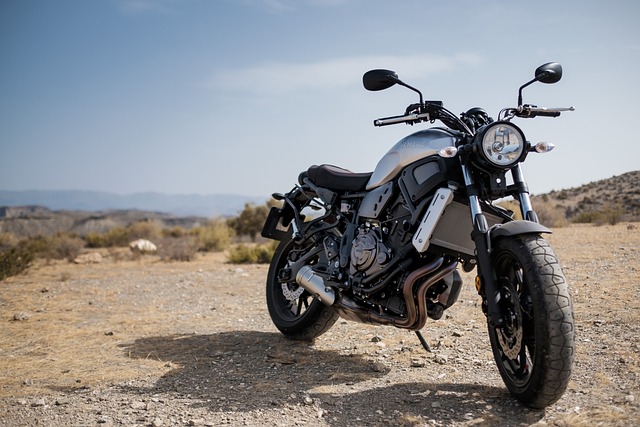When it comes to motorcycle maintenance, understanding and addressing issues with your motorcycle battery is crucial for a reliable ride. This article delves into the common problems that can affect your bike’s power source, from self-discharge to sulphation, and provides practical solutions for each. Whether you’re dealing with a dead battery or looking to maintain its health over time, learn how to diagnose and fix these issues, ensuring your motorcycle battery operates at peak performance. From the basics of battery functioning to when it’s time for replacement, equip yourself with the knowledge to keep your ride ready to go whenever you are.
- Understanding Your Motorcycle's Battery: The Basics
- Common Motorcycle Battery Problems and Symptoms
- Self-Discharge: Causes and Solutions for Motorcycle Batteries
- Sulphation in Motorcycle Batteries: Identification and Prevention Techniques
- How to Handle a Dead or Weak Motorcycle Battery
- Charging and Maintaining Your Motorcycle Battery Correctly
- When to Replace Your Motorcycle Battery: Signs and Considerations
Understanding Your Motorcycle's Battery: The Basics

When addressing common motorcycle battery issues and fixes, it’s crucial to have a solid understanding of your motorcycle’s battery system. The motorcycle battery is the heart of the electrical system on your bike, providing the necessary voltage to power the ignition, lighting, and electronic fuel injection systems. It’s a rechargeable energy storage device, typically lead-acid, AGM (Absorbent Glass Mat), or lithium-ion types. Regular maintenance and knowledge of its function are key to preventing issues that could leave you stranded. To begin with, ensure the battery is securely mounted on the bike; vibrations can cause internal damage over time. Check the battery’s charge level regularly, as a low charge can lead to difficulty starting your motorcycle. Additionally, inspect the terminals and cables for corrosion or looseness, as these can impede electrical flow and reduce performance. Understanding the basics of your motorcycle’s battery, including its type, how it functions, and the signs of wear and tear, is essential for troubleshooting any issues that arise. Regularly cleaning the terminals with a baking soda solution and a wire brush can prevent corrosion, ensuring optimal conductivity. By keeping an eye on these elements, you can proactively maintain your motorcycle’s battery health and address any problems before they escalate, guaranteeing your bike’s reliability and safety on the road.
Common Motorcycle Battery Problems and Symptoms

Self-Discharge: Causes and Solutions for Motorcycle Batteries

Self-discharge is a common issue that affects motorcycle batteries, leading to reduced performance and premature failure if left unaddressed. This phenomenon occurs when the battery gradually loses charge even though no electrical draw is present. It’s a natural process that all lead-acid batteries experience due to their design, but certain factors can exacerbate it. High temperatures, for instance, accelerate self-discharge, as do poor connections and a sulfation buildup within the battery. To mitigate this issue, regular maintenance checks are essential. Ensure the battery is securely mounted and that all terminals and connections are clean, tight, and free from corrosion. Additionally, using a battery tender or maintainer during periods of extended inactivity can help maintain the battery’s charge level. For batteries with hydrogen sulfide issues, installing a desulfator or maintaining regular equalization charges can reduce the rate of self-discharge. Choosing a battery with a lower Self-Discharge Rate (SDR) and investing in a good quality charger can also be proactive measures to ensure your motorcycle’s battery remains healthy and reliable, ready for your next ride.
Sulphation in Motorcycle Batteries: Identification and Prevention Techniques

Sulphation is a common issue that can affect the performance and longevity of a motorcycle battery, leading to premature battery failure if left unchecked. This process occurs when sulfur crystals form on the lead plates within the battery, which can reduce the battery’s ability to hold a charge. Identifying sulphation often involves monitoring the battery’s voltage and capacity over time. A fully charged motorcycle battery typically holds a voltage of around 12.6 volts; if the voltage drops below this range when the bike is running, it may indicate partial sulphation. To prevent sulphation, regular maintenance is key. This includes keeping the battery fully charged, as batteries left in a discharged state for extended periods are more prone to sulphation. Additionally, avoiding frequent deep discharges can help, as these can accelerate the process. Regularly charging the battery after use and ensuring it’s not exposed to extreme temperatures will also aid in its prevention. Employing a battery charger or maintainer designed for motorcycle batteries, which can automatically keep the charge at optimal levels, is an effective way to mitigate this issue. Regular inspections of the battery, checking for any signs of swelling or white powdery deposits on the lead plates, can also assist in early detection and intervention before sulphation becomes severe. With proper care and attention, motorcycle owners can significantly reduce the risk of sulphation and ensure their batteries operate efficiently for the longest possible time.
How to Handle a Dead or Weak Motorcycle Battery

When faced with a dead or weak motorcycle battery, it’s crucial to act promptly to diagnose and address the issue effectively. Begin by checking the battery charge level using a multimeter. A reading below 12.4 volts typically indicates that the battery is discharged and requires recharging. If the battery is not holding a charge, inspect it for any visible signs of damage or corrosion on the terminals. Clean the terminals with a wire brush to remove any grime or oxidation, which can interrupt the connection and affect battery performance.
Should the battery still not function after cleaning, consider charging it with a suitable battery charger. Connect the charger according to the battery type—whether it’s a lead-acid, AGM, or lithium battery—and follow the manufacturer’s guidelines for charging times and voltages. It’s also wise to regularly check the health of your motorcycle battery through periodic voltage readings and ensure that the charge level is sufficient for your next ride. Properly maintaining your motorcycle battery by keeping it charged, clean, and free from corrosion can significantly extend its lifespan and prevent recurrent issues. Remember to store the bike or remove the battery if it won’t be used for an extended period to avoid self-discharge and ensure readiness when you next hit the road.
Charging and Maintaining Your Motorcycle Battery Correctly

When it comes to maintaining your motorcycle’s performance and reliability, ensuring that your battery is in good health is paramount. A well-maintained motorcycle battery not only prolongs its lifespan but also ensures that you won’t be stranded due to a dead battery. The first step in proper maintenance is understanding how and when to charge your motorcycle battery. Unlike car batteries, which are often maintained by an alternator while driving, motorcycle batteries may require manual charging. Regular charging sessions, typically every one to two months, can prevent the battery from discharging completely, a condition known as “sulfation,” which can impair battery performance or even render it unusable.
To maintain your motorcycle battery effectively, it’s crucial to use a suitable charger designed specifically for motorcycle batteries. These chargers are tailored to provide the correct voltage and amperage for optimal charging without causing damage. Additionally, always follow the manufacturer’s guidelines for charging times and frequencies. Proper maintenance also involves regular checks of the battery’s charge level, which can be done using a hydrometer or a voltmeter. Monitoring the water levels in lead-acid batteries and topping off the electrolyte with distilled water, if necessary, is essential for maintaining the battery’s state of charge. By adhering to these practices, you can significantly reduce the likelihood of encountering battery issues on the road and ensure that your motorcycle’s starting system operates smoothly.
When to Replace Your Motorcycle Battery: Signs and Considerations

When the time comes to replace your motorcycle’s battery, it’s crucial to identify the signs early to avoid being stranded. Typically, a motorcycle battery has a lifespan of about two to four years, depending on usage and maintenance. If your bike starts with considerable difficulty, or the engine cranks sluggishly, it may be time for a new battery. Additionally, if you notice that your lights are dimmer than usual, or the battery warning light is illuminated on your dashboard, these are clear indicators that the battery’s capacity is diminishing. Regular maintenance checks, such as inspecting the terminals for corrosion and ensuring the battery is securely mounted, can help prolong its life. Monitoring the charge levels with a battery charger or tender when the bike is in storage can also prevent premature failure. Ultimately, investing in a high-quality motorcycle battery and adhering to proper maintenance practices will ensure your ride remains reliable and ready to go whenever you are.
